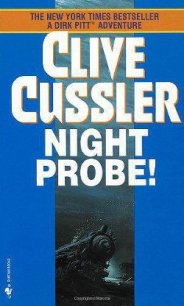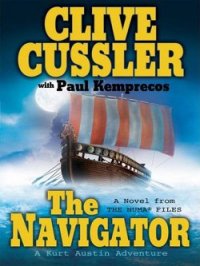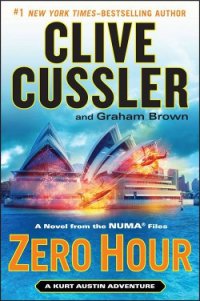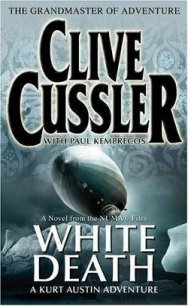Inca Gold - Cussler Clive (читать онлайн полную книгу .TXT) 📗
"No sign of criminal activity in the records?" asked Gaskill.
"Nothing that stands out. We'll need a good month for an audit to know for certain if we have a case. What did you dig up on your end?"
"So far every object we've studied checks clean. No stolen goods anywhere."
"Then we've performed another abortion."
Gaskill sighed. "I hate to say it, but it appears the Zolars are a hell of a lot smarter than the best combined investigative teams the United States government can field."
A few moments later, the two Customs agents who had worked with Gaskill on the Rummel raid in Chicago, Beverly Swain and Winfried Pottle, stepped into the office. Their manner was official and businesslike, but there was no hiding the slight upward curl of their lips. Ragsdale and Gaskill had been so absorbed in their private conversation that they hadn't noticed the two younger Customs agents had not entered through the office door, but from the adjoining, private bathroom.
"Got a minute, boss?" Beverly Swain asked Gaskill.
"What is it?"
"I think our instruments have detected some sort of shaft leading under the building," answered Winfried Pottle.
"What did you say?" Gaskill demanded quickly.
Ragsdale looked up. "Instruments?"
"The ground-penetrating sonic/radar detector we borrowed from the Colorado School of Mines," explained Pottle. "Its recording unit shows a narrow space beneath the warehouse floor leading into the earth."
A faint ray of hope suddenly passed between Ragsdale and Gaskill. They both came to their feet. "How did you know where to look?" asked Ragsdale.
Pottle and Swain could not contain their smiles of triumph. Swain nodded at Poole who answered, "We figured that any passageway leading to a secret chamber had to start or end at Zolar's private office, a connective tunnel he could enter at his convenience without being observed."
"His personal bathroom," Gaskill guessed wonderingly.
"A handy location," Swain confirmed.
Ragsdale took a deep breath. "Show us."
Pottle and Swain led them into a large bathroom with a marble floor and an antique sink, commode, and fixtures, with teak decking from an old yacht covering the walls. They motioned to a modern sunken tub with a Jacuzzi that seemed oddly out of place with the more ancient decor.
The shaft drops under the bathtub," said Swain, pointing.
Are you sure about this?" asked Ragsdale skeptically. "The shower stall strikes me as a more practical setup for an elevator."
"Our first thought too," answered Pottle, "but our instrument showed solid concrete and ground beneath the shower floor."
Pottle lifted a long tubular probe that was attached by an electrical cable to a compact computer with a paper printout. He switched on the unit and waved the end of the probe around the bottom of the tub. Lights on the computer blinked for a few seconds and then a sheet of paper rolled through a slot on the top. When the recording paper stopped flowing, Pottle tore it off and held it up for everyone to see.
In the center of an otherwise blank sheet of paper, a black column extended from end to end.
"No doubt about it," announced Pottle, "a shaft with the same dimensions as the bathtub that falls underground."
"And you're sure your electronic marvel is accurate?" said Ragsdale.
"The same type of unit found previously unknown passages and chambers in the Pyramids of Giza last year."
Gaskill said nothing as he stepped into the tub. He fiddled with the nozzle, but it simply adjusted for spray and direction. Then he sat down on a seat large enough to hold four people. He turned the gold-plated hot and cold faucets, but no water flowed through the spout.
He looked up with a big smile. "I think we're making progress."
Next he wiggled the lever that raised and lowered the plug. Nothing happened.
"Try twisting the spout," suggested Swain.
Gaskill took the gold-plated spout in one of his massive hands and gave it a slight turn. To his surprise it moved and the tub began to slowly sink beneath the bathroom floor. A reverse turn of the spout and the tub returned to its former position. He knew, he knew, this simple little water spout and this stupid bathtub were the keys that could topple the entire Zolar organization and shut them down for good. He gave a come-hither motion to the others and said gleefully, "Going down?"
The unusual elevator descended for nearly thirty seconds before coming to a stop in another bathroom. Poole judged the drop to be about 20 meters (65 feet). They stepped from the bathroom into an office that was almost an exact copy of the one above. The lights were on but no one was present. With Ragsdale in the lead, the little group of agents cracked open the door of the office and peered out onto the floor of an immense storehouse of stolen art and antiquities. They were all stunned by the size of the chamber and the enormous inventory of the objects. Gaskill made a wild guess of at least ten thousand pieces as Ragsdale slipped into the storeroom and made a fast recon. He was back in five minutes.
"Four men working with a forklift," he reported, "lowering a bronze sculpture of a Roman legionnaire into a wooden crate about halfway down the fourth aisle. Across on the other side, in a closed-off area, I counted six men and women working in what looked to be the artifact forgery section. A tunnel leads through the south wall, I'd guess to a nearby building that acts as a front for the shipping and receiving of the stolen property."
"It must also be used for the covert employees to enter and exit," suggested Pottle.
"My God," murmured Gaskill. "We've hit the jackpot. I can recognize four works of stolen art from here."
"We'd better stay put," said Ragsdale softly, "until we can shuttle reinforcements from above."
"I volunteer to operate the ferry service," said Swain with a foxy grin. "What woman can pass up the opportunity to sit in a fancy bathtub that moves from floor to poor?"
As soon as she left, Poole stood guard at the door to the storage area while Gaskill and Ragsdale searched Zolar's underground office. The desk produced little of value so they turned their attention to searching for a storeroom. They quickly found what they were looking for behind a tall sideboard bookcase that swiveled out from the wall on small castors. Pushed aside, it revealed a long, narrow chamber lined with antique wooden cabinets, standing floor to ceiling. Each cabinet held file folders in alphabetical order containing acquisition and sales records of the Zolar family operations as far back as 1929.
"It's here," muttered Gaskill in wonder. "It's all here." He began pulling files from a cabinet.
"Incredible," Ragsdale agreed, studying files from another cabinet that stood in the middle of the storeroom. "For sixty-nine years they kept a record of every piece of art they stole, smuggled, and forged, including financial and personal data on the buyers."
"Oh, Jesus," Gaskill groaned, "take a look at this one."
Ragsdale took the offered file and scanned the first two pages. When he looked up his face was marked with disbelief. "If this is true, Michelangelo's statue of King Solomon in the Eisenstein Museum of Renaissance Art in Boston is a fake."




